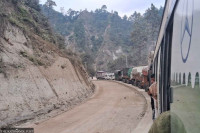Opinion
Moving beyond two, stuck in three
The upsurge of the Gender and Sexual Minorities’ (GSM) movement has continually posed challenges to rigid norms perpetuated by the gender binary.
Rukshana Kapali
The upsurge of the Gender and Sexual Minorities’ (GSM) movement has continually posed challenges to rigid norms perpetuated by the gender binary.
Within more than a decade since the movement, people who identify beyond the static notions of two genders are coming out, gaining visibility in society, and carving spaces for more people to talk about their feelings and expressions.
While a progressive and inclusive step to add one more gender option was taken by the government a decade ago, I am afraid that we have fallen into a new limiting and exclusionary trap: the ‘gender trinary’.
The issue of identity—including questions on who defines it and in what terms—is a political subject. The GSM upsurge in Nepal has made many groundbreaking achievements despite maneuvering through a conservative social reality.
These achievements have not just been landmark for the GSM population in Nepal, but have also garnered international praise and recognition. While discussions beyond the gender binary is coming to the limelight, a few problematic notions continue to linger.
The government provides citizenship to transgender people in the category ‘Other’. One can either choose the gender ‘O’ and replace their birth name with their preferred name and also appear on pictures as they identify; or one needs to use their birth assigned sex, name and appear in pictures the same way. If any individual chooses the category ‘O’, for any following parts of the form where one is to be addressed by any relational term, the word ‘other’ is continually used.
For example, sentences that appear as a result include ‘Abc and Xyz’s other took birth on DD/MM/YYYY’, ‘GHI is abc’s other’ and ‘Other GHI has filled this form.’ Instead of daughter/son/child, Mister/Miss/Mrs/M, the word ‘other’ is placed everywhere, which does not make sense at all.
Sometimes it makes me think that the state lacks basic understanding about gender diversity and—despite being heralded as an LGBTIQ+- friendly government in South Asia—does not have a grasp of gender as a spectrum. Dumping anyone who does not stereotypically fall under the social rigid norms of being a man or woman into one category is simply an escape passage. The mindset shaping the citizenship process is still highly cisnormative.
The legal vernacular in Nepal also does not distinguish between the terms ‘Sex’ and ‘Gender’. One of the reasons for this oversight is that the sole official language of this country, i.e. Nepali (Parbate Kura) does not distinguish it too.
There is a need for linguistic activism that focuses on incorporating such important terminologies and distinctions into social and legal vocabulary. The law does not address the need for ‘preferred gender terms’, where one can choose to be called as ‘he/son/Mr/sir’ or ‘she/daughter/Ms/mam’ or ‘they/child/M/person).
In the general GSM movement of Nepal, which has been focused more on acquiring rights, other problematic obstacles have not been addressed. One of these obstacles includes the lack of fluidity in how the state understands transgender identities and experiences; it is beyond singularity and is rooted in and shaped by individuals.
There are transgender people who identify as ‘third gender’, reflecting a cultural gender identity prominent in South Asia. Cultural gender identities exist around various indigenous communities of the world. To name a few examples, the fa’afafine in Samoa, leiti in Tonga, vakasalewalewa in Fiji, hijra in India, third gender in mainstream Hindu cultures of South Asia, among other numerous examples. There are transgender people who identify as ‘man’ or ‘woman’. And there are people who identify between and across those terms.
When I talk about myself, I identify as a transgender woman and keep this identity within the woman spectrum. I do not see it as something distinct from womanhood. This is with a recognition that while my identity as a transgender woman differs from cisgender women, it is still a part of the woman spectrum.
People who identify as gender non-conforming, genderqueer, genderfluid, agender, androgyne, and a lot more gender identities have continually been overlooked and misrepresented in discussions about gender rights. The issue of intersex people, who have biological sex that is neither distinctively male not distinctively female, have a different ‘sex identity’, and have different gender identities as man, woman, transman, transwoman, non-conforming and so on, have also been excluded from the mainstream discourse in Nepal.
Addressing diverse gender identities has been presented as a ‘burden’ to legal frameworks. This reflects the deep rooted cisnormality in Nepal and the general attitude of the state towards addressing the needs of historically suppressed and marginalised groups.
This burden perspective will continue to shape how the movement to progress beyond the gender binary continues to advance in Nepal. The idea of gender as spectrum needs to be proffered rather than perpetuating the ‘Gender Trinary’—another rigid system that is just as harmful, limiting and exclusionary as its predecessor.
Kapali is an activist and blogger vocal on LGBTI and Newa issues.




 13.98°C Kathmandu
13.98°C Kathmandu












